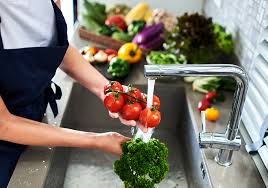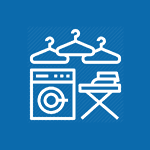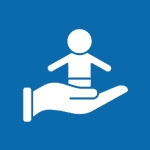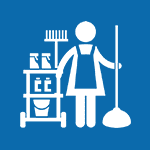
Cleaning Guide to protect against COVID19
Cleaning and disinfecting high-touch surfaces in your home regularly is an important precaution to lower the risk of infection.
Follow cleaning product instructions for safe and effective use, including precautions you should take when applying the product, such as wearing gloves and making sure you have good ventilation.
 High-touch surfaces to clean and disinfect
High-touch surfaces to clean and disinfect
If a surface is dirty, first clean it with soap or detergent and water. Then use a disinfectant product containing alcohol (of around 70 per cent) or bleach. Vinegar and other natural products are not recommended.
Clean and disinfect high-touch surfaces daily in household common areas (e.g. tables, hard-backed chairs, doorknobs, light switches, phones, tablets, touch screens, remote controls, keyboards, handles, desks, toilets, sinks)
How to disinfect
Hard (Non-porous) Surfaces
If surfaces are dirty, they should be cleaned using a detergent or soap and water prior to disinfection.
Wear disposable gloves when cleaning guide and disinfecting surfaces. Gloves should be discarded after each cleaning.
Diluted household bleach solutions (at least 1000ppm sodium hypochlorite) can be used if appropriate for the surface, ensuring a contact time of at least 1 minute. Allow proper ventilation during and after application.
- Prepare a bleach solution by mixing:
- 5 tablespoons (1/3rd cup) bleach per gallon of water or
- 4 teaspoons bleach per quart of water
- Bleach solutions will be effective for disinfection up to 24 hours.
Soft (Porous) Surfaces
For soft (porous) surfaces such as carpeted floor, rugs, and drapes, remove visible contamination if present and clean with appropriate cleaners indicated for use on these surfaces. After cleaning:
Launder items as appropriate in accordance with the manufacturer’s instructions. If possible, launder items using the warmest appropriate water setting for the items and dry items completely.
Electronics
For electronics such as cell phones, tablets, touch screens, remote controls, and keyboards, remove visible contamination if present.
Follow the manufacturer’s instructions for all cleaning and disinfection products.
Consider use of wipe-able covers for electronics.
If no manufacturer guidance is available, consider the use of alcohol-based wipes or sprays containing at least 70% alcohol to disinfect touch screens. Dry surfaces thoroughly to avoid pooling of liquids.
Cleaning clothes
It is currently unclear how long the COVID-19 virus can survive on fabric, but many items of clothing have plastic and metal elements on which it might live for a few hours to several days.
Doing laundry at home Cleaning Guide
Clean bed sheets, towels and clothes regularly.
Don’t shake dirty laundry to minimize the possibility of dispersing the virus through the air.
Launder items with soap or detergent, using the warmest appropriate water setting and dry items completely — both steps help to kill the virus.
Wash your hands with soap and water, or use an alcohol-based hand rub, immediately afterwards.
Clean and disinfect clothes hampers according to guidance above for surfaces. If possible, consider placing a bag liner that is either disposable (can be thrown away) or can be laundered.
Doing laundry outside your home

While the actual process of washing with powerful industrial grade detergents at a high temperature inactivates the virus, the real threat would the manner in which the clothes are handled and the number of hands it passes through before being packaged. It is not recommended however If you must use laundry facilities outside of your home, take sensible precautions as contamination during handling cannot be ruled out.

Hand hygiene and other preventive measures
Household members should clean hands often, including immediately after removing gloves and after contact with an ill person, by washing hands with soap and water for 20 seconds. If soap and water are not available and hands are not visibly dirty, an alcohol-based hand sanitizer that contains at least 70% alcohol may be used. However, if hands are visibly dirty, always wash hands with soap and water.
Household members should follow normal preventive actions while at work and home including recommended hand hygiene and avoiding touching eyes, nose, or mouth with unwashed hands.
- Additional key times to clean hands include:
- After blowing one’s nose, coughing, or sneezing
- After using the restroom
- Before eating or preparing food
- After contact with animals or pets
- Before and after providing routine care for another person who needs assistance (e.g. a child).
- Exercise caution and common sense. Good practices to consider include removing your shoes when you enter your home and changing into clean clothes when you return home after being in crowded places, and washing your hands with soap and water immediately afterwards.
Handling and preparing food
While at present there is no evidence of people catching the COVID-19 virus from food or food packaging, it may be possible that people can become infected by touching a surface or object contaminated by the virus and then touching their face.
The greater risk comes from being in close contact with other people while outside food shopping or receiving a food delivery (as receiving any delivery in areas with local transmission). As always, good hygiene is important when handling food to prevent any food-borne illnesses.

Food packaging and handling precautions
Remove any unnecessary packaging and dispose into a waste bin with a lid.
Remove food from take-out containers, place on a clean plate and dispose of the container.
Packaging like cans can be wiped clean with a disinfectant before being opened or stored.
Wash unpackaged produce, such as fruit and vegetables, thoroughly under running water.
Wash your hands with soap and water, or use an alcohol-based hand rub, immediately afterwards. Food cleaning guide should not be foget.
(Most government agencies recommend simply washing with running water, scrubbing with a vegetable brush as needed rather than using special produce washes, which can add new deposits.
Felicia Goulet-Miller, an instructor of microbiology at Florida Gulf Coast University, said food items, including fresh produce, can spread the disease.
“If the produce is contaminated by a sick person and you touch it and then touch your face, you can become infected,” Goulet-Miller said, “Noting, it’s another reason not to touch your faces in public and to wash hands after touching things touched by others – USAtoday.com)
(Credit: WHO, CDC & NHS Websites & announcements.)

 High-touch surfaces to clean and disinfect
High-touch surfaces to clean and disinfect













